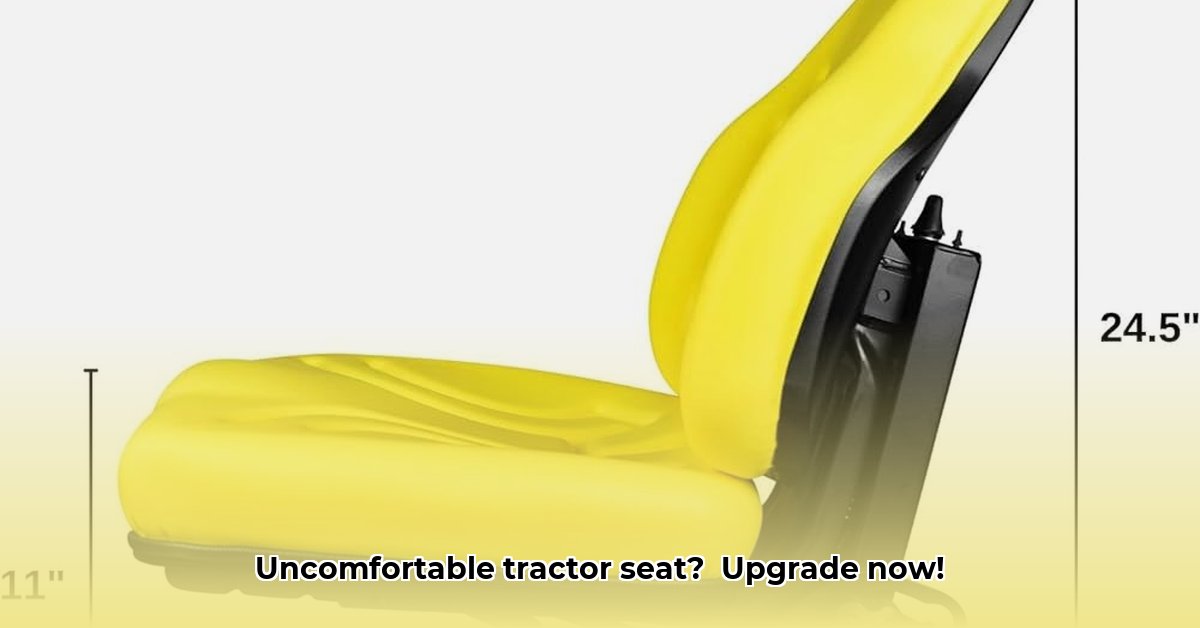
Spending hours on a tractor shouldn't leave you aching. Upgrading your John Deere tractor seat is an investment in your comfort, health, and ultimately, your farm's productivity. This guide provides a step-by-step approach to selecting and installing the perfect seat upgrade for you. For more detailed information on John Deere tractor seats, check out this helpful resource: John Deere Seats.
Assessing Your Current Seat: A Necessary First Step
Before exploring new options, honestly evaluate your current seat. Is it worn, uncomfortable, or lacking essential support? Does it contribute to back pain or fatigue? Consider these factors:
- Daily Usage: How many hours do you spend on the tractor daily? Longer hours demand higher comfort levels.
- Terrain: Do you primarily work on flat land or rougher terrain? Suspension greatly matters in uneven conditions.
- Work Type: Does your work involve heavy loading or precise movements? The required features will vary depending on your tasks.
Addressing these key points will help pinpoint the features you need in a new seat. Answering these questions helps determine if a simple upgrade or an entirely new replacement is necessary. For instance, a simple lumbar support addition might be sufficient for some, while others might need a complete suspension system replacement for a better ergonomic setup. This preliminary assessment will inform your choice of seat.
Exploring Your Seat Upgrade Options
John Deere offers OEM (Original Equipment Manufacturer) parts, but many aftermarket options exist. Aftermarket seats often provide more features for a lower cost, but always confirm compatibility with your tractor model. Thoroughly research various models, reading reviews from other farmers to gain real-world perspectives.
Key Features to Prioritize
When comparing seats, focus on these essential aspects:
Suspension System: This is crucial for reducing vibrations and bumps, significantly impacting comfort during long hours of operation. Look for advanced suspension systems, such as air suspension for maximum comfort and reduced fatigue during long workdays, as these significantly minimize the impact of vibrations on your body. This leads to less fatigue and, ultimately, higher productivity.
Adjustability: Height, lumbar support, tilt, and armrests allow for personalized comfort. The greater the adjustability, the better the chance of finding a perfectly suited position to minimize strain.
Materials: Breathable, high-density foam provides superior cushioning and support. Consider climate control features (heating and cooling) for year-round comfort.
Durability: Check the warranty and material quality for long-term use. A durable seat will withstand the rigors of daily farm work and endure the harsh elements over time.
Choosing the Right Seat: A Comparative Analysis
The following table compares hypothetical seat options (prices are estimates and can vary):
| Feature | Budget-Friendly Option | Mid-Range Option | Premium Option |
|---|---|---|---|
| Suspension | Basic | Improved suspension | Advanced air suspension |
| Adjustability | Limited | Multiple adjustments | Extensive adjustments |
| Materials | Standard vinyl | High-density foam | Premium breathable fabric, climate control |
| Price Range | $300 - $700 | $700 - $1500 | $1500+ |
Remember to verify compatibility with your specific John Deere tractor model before purchasing. Don't hesitate to contact your local John Deere dealer for assistance.
Step-by-Step Seat Installation Guide
The installation process may vary slightly depending on the specific seat model. Always consult the manufacturer's instructions. However, these general steps apply:
Safety First: Disconnect the tractor battery to prevent electrical shocks.
Remove Old Seat: Carefully remove the old seat, taking photos or notes of the bolt and connector placement.
Prepare New Seat: Review the new seat's installation guide and ensure compatibility.
Mount New Seat: Securely attach the new seat using the provided hardware.
Reconnect Battery: Reconnect the tractor battery once installation is complete.
Test and Adjust: Adjust the seat for optimal comfort and driving position.
The ROI of a Comfortable Seat
Upgrading your tractor seat isn't just about comfort; it's a strategic investment. Reduced fatigue leads to increased productivity, fewer errors, and potentially lower healthcare costs. A comfortable operator is a more efficient and safer operator. The long-term benefits far outweigh the initial cost. Think of your seat upgrade as a crucial aspect of both your physical well-being and your business profitability.
Dr. Anya Sharma, Ergonomics Specialist at the Agricultural Engineering Institute, states, "Investing in ergonomic seating solutions directly translates to increased operator productivity and significantly reduces the risk of musculoskeletal disorders, ultimately boosting your bottom line."